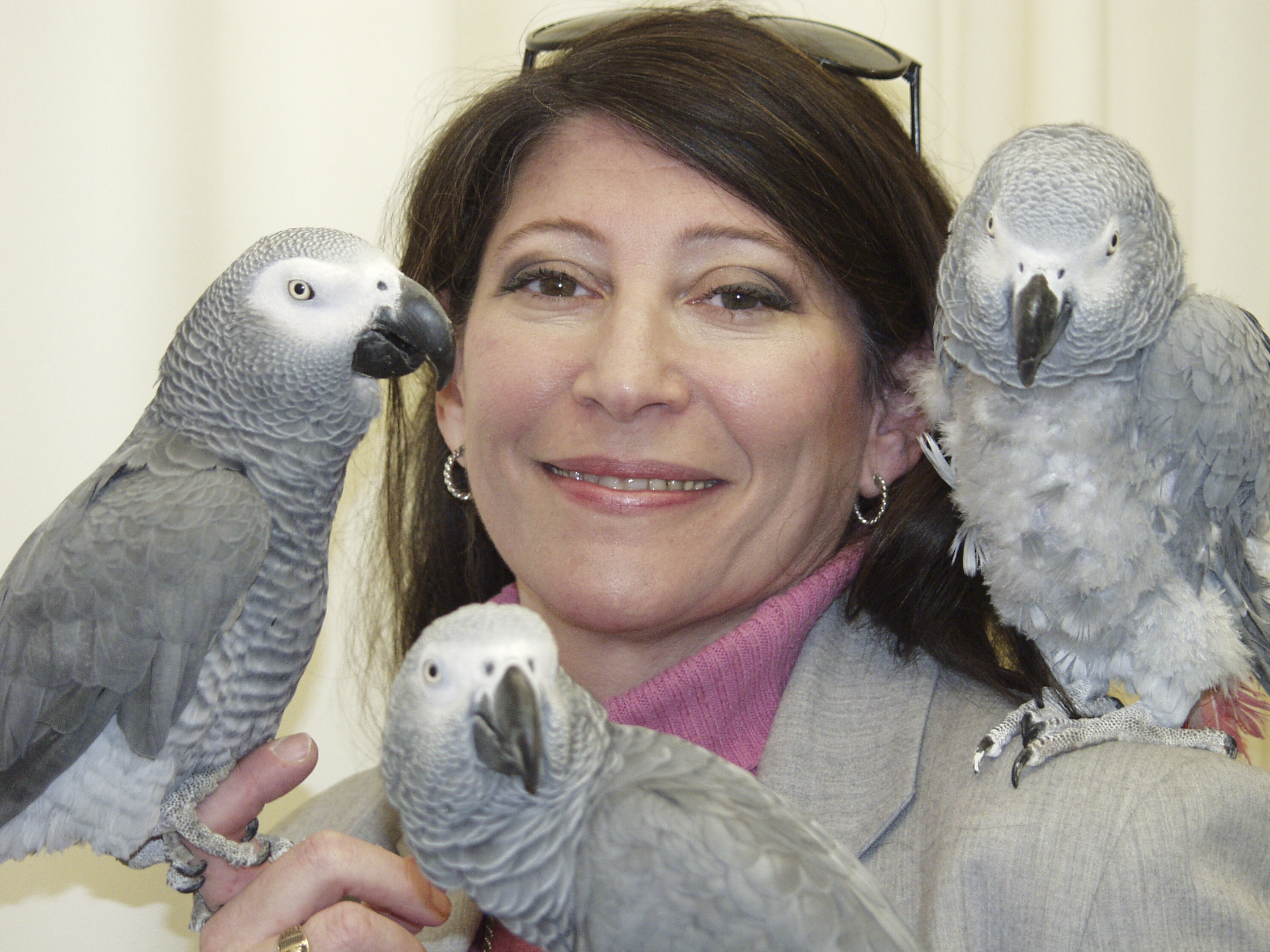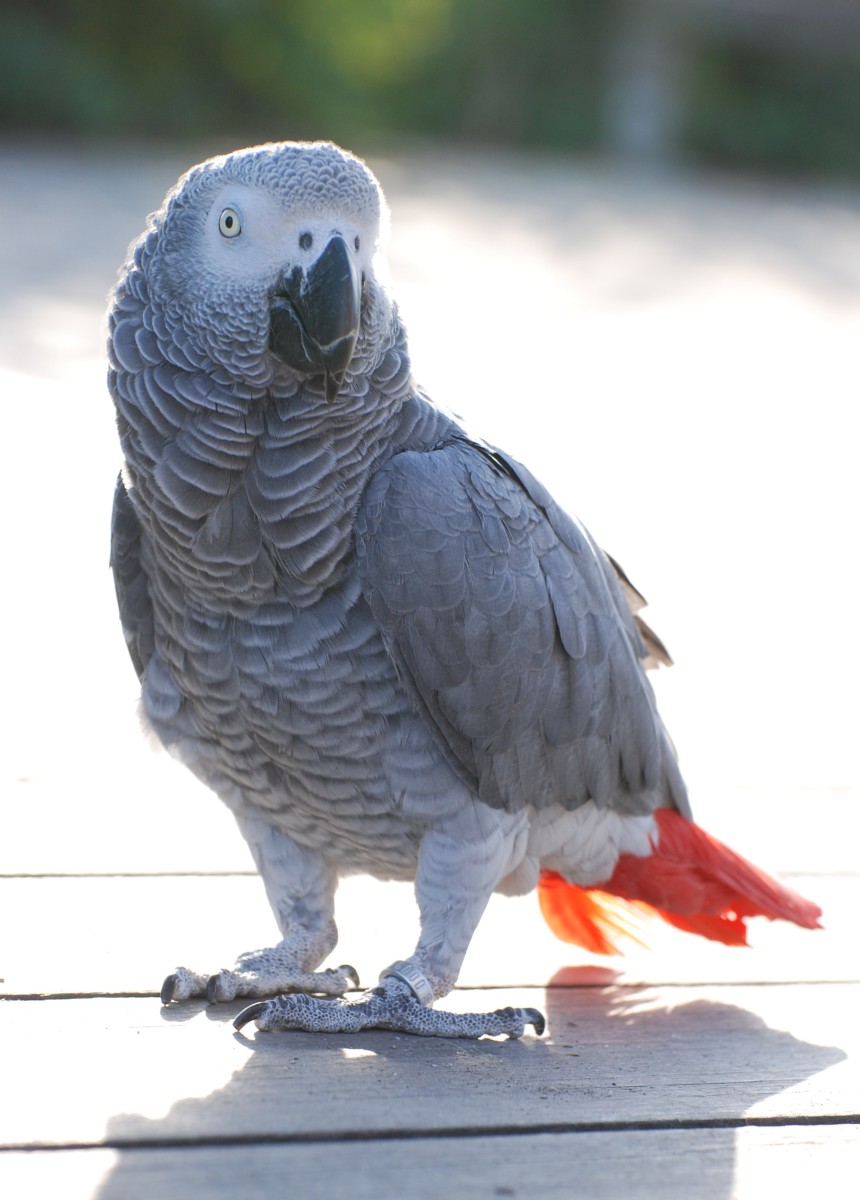Meet Alex
Dr. Irene Pepperberg
Training
Accomplishments
Critical Review
Death
Meet Alex
Dr. Irene Pepperberg
Training
Accomplishments
Critical Review
Death
Alex (1976 – September 6, 2007) was an African grey parrot and the subject of a thirty-year (1977 – 2007) experiment by animal psychologist Irene Pepperberg, initially at the University of Arizona and later at Harvard University and Brandeis University.


When Alex was about one year old, Pepperberg bought him at a pet shop. The name "Alex" was an acronym for avian language experiment, but Pepperberg later cited the name as meaning avian learning experiment to evoke further acceptance in her research field, a then-touchy topic (explained in her book, Alex & Me).
Before Pepperberg's work with Alex, it was widely believed in the scientific community that a large primate brain was needed to handle complex problems related to language and understanding; birds were not considered to be intelligent as their only common use of communication was of mimicking and the repetition of sounds to interact with each other. However, Alex's accomplishments supported the idea that birds may be able to reason on a basic level and use words creatively. Pepperberg wrote that Alex's intelligence was on a par with that of dolphins and great apes. She also reported that Alex had the intelligence of a five-year-old human and had not even reached his full potential by the time he died. She said that the bird had the emotional level of a human two-year-old at the time of his death.
Alex's training used a model/rival technique, where the student (Alex) observes trainers interacting. One of the trainers models the desired student behavior, and is seen by the student as a rival for the other trainer's attention. The trainer and model/rival exchange roles so the student can see that the process is interactive. Pepperberg reported that during times when she and an assistant were having a conversation and made mistakes, Alex would correct them.
This technique helped Pepperberg succeed with Alex where other scientists had failed in facilitating two-way communication with parrots. In later years, Alex sometimes assumed the role of one of Pepperberg's assistants by acting as the "model" and "rival" in helping to teach a fellow parrot in the lab. Alex sometimes practiced words when he was alone.





Pepperberg was modest in her descriptions of Alex's accomplishments, not claiming that he could use "language" but instead saying that he used a two-way communications code. Listing Alex's accomplishments in 1999, Pepperberg said he could identify 50 different objects and recognize quantities up to six; that he could distinguish seven colors and five shapes, and understand the concepts of "bigger", "smaller", "same", and "different", and that he was learning "over" and "under". When asked questions in the context of research testing, he gave the correct answer approximately 80% of the time.
Alex had a vocabulary of over 100 words, but was exceptional in that he appeared to have understanding of what he said. For example, when Alex was shown an object and was asked about its shape, color, or material, he could label it correctly. He could understand that a key was a key no matter what its size or color, and could figure out how the key was different from others. He asked what color he was, and learned "grey" after being told the answer six times.
Alex passed increasingly difficult tests measuring whether humans have achieved Piaget's Substage 6 object permanence. Alex showed surprise and anger when confronted with a nonexistent object or one different from what he had been led to believe was hidden during the tests.
Alex understood the turn-taking of communication and often the syntax used in language. He called an apple a "banerry", which a linguist friend of Pepperberg's thought to be a combination of "banana" and "cherry," two fruits he was more familiar with.
Alex also showed some comprehension of personal pronouns; he used different language when referring to himself or others, indicating a concept of "I" and "you".
Pepperberg was training Alex to recognize English phonemes, in the hope that he would conceptually relate an English written word with the spoken word. He could identify sounds made by two-letter combinations such as SH and OR.
Alex could even add, to a limited extent, correctly giving the number of similar objects on a tray. Pepperberg said that if he could not count, the data could be interpreted as his being able to quickly and accurately estimate the number of something, better than humans can.
Preliminary research also seems to indicate that Alex could carry over the concept of four blue balls of wool on a tray to four notes from a piano. Pepperberg was also training him to recognize "4" as "four".
In July 2005, Pepperberg reported that Alex understood the concept of zero. If asked the difference between two objects, he also answered that; but if there was no difference between the objects, he said "none", which meant that he understood the concept of nothing or zero.
When he was tired of being tested, he would say "Wanna go back," meaning he wanted to go back to his cage, and in general, he would request where he wanted to be taken by saying "Wanna go...", protest if he was taken to a different place, and sit quietly when taken to his preferred spot. He was not trained to say where he wanted to go, but picked it up from being asked where he'd like to be taken.
If the researcher displayed irritation, Alex tried to defuse it with the phrase, "I'm sorry." If he said "Wanna banana," but was offered a nut instead, he stared in silence, asked for the banana again, or took the nut and threw it at the researcher or otherwise displayed annoyance, before requesting the item again.
Once, Alex was given several different colored blocks (two red, three blue, and four green—similar to the picture above). Pepperberg asked him, "What color three?" expecting him to say blue. However, as Alex had been asked this question before, he seemed to have become bored. He answered "five!" This kept occurring until Pepperberg said "Fine, what color five?" Alex replied "none". This suggests that parrots, like children, get bored. Sometimes, Alex purposely answered the questions incorrectly, despite knowing the correct answer.
Some in the scientific community are skeptical of Pepperberg's findings, pointing to Alex's communications as operant conditioning. Critics point to the case of Clever Hans, a horse who could apparently count, but who was actually understanding subtle cues from the questioner.
In another case, Nim Chimpsky, a chimpanzee was thought to be using language, but there is some debate over whether he simply imitated his teacher. Dr. Herbert Terrace, who worked with Nim Chimpsky, says he thinks Alex performed by rote rather than using language; he calls Alex's responses "a complex discriminating performance", adding that in every situation, "there is an external stimulus that guides his response."
However, supporters of Alex mention that Alex was able to talk to and perform for anyone involved in the project as well as complete strangers who recorded findings unassisted and during first contact with the bird, making the arguments of rote learning and operant conditioning difficult to substantiate.

Alex died on September 6, 2007, at the age of 31. Alex's death came as a surprise; the average life span for African grey parrots is sixty years. He appeared healthy the day prior, but was found dead in the morning. According to a press release issued by the Alex Foundation, "Alex was found to be in good health at his most recent annual physical about two weeks [before his death]. According to the veterinarian who conducted the necropsy, there was no obvious cause of death." According to Pepperberg, Alex's loss will not stop the research, but will be a setback. The lab has two other birds, but they are not comparable to Alex.
The Alex Foundation posted the pathology results on October 4:
Alex died quickly. He had a sudden, unexpected event associated with arteriosclerosis (hardening of the arteries). It was either a fatal arrhythmia, heart attack or stroke, which caused him to die suddenly with no suffering. There was no way to predict his demise. All of his tests, including his cholesterol level and asper levels, came back normal earlier that week. His death could not be connected to his current diet or his age; our veterinarian said that she has seen similar events in young (less than 10 year old) birds on healthy diets. Most likely, genetics or the same kind of low-level (impossible to detect in birds as yet) inflammatory disease that is related to heart disease in humans was responsible.
Alex's last words to Pepperberg were: "You be good, see you tomorrow. I love you." These were the same words that he would say every night when Pepperberg left the lab.